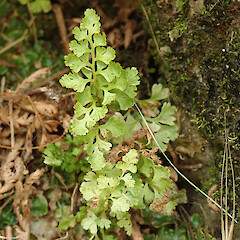Anogramma leptophylla
Common name
Jersey fern, annual fern
Synonyms
Polypodium leptophyllum L., Grammitis leptophylla Swartz, Gymnogramme leptophylla Desv., Gymnogramme novae-zelandiae Colenso; Osmunda leptophylla (L.) Savigny in Lam.; Hemionitis leptophylla (L.) Lag.; Acrostichum leptophyllum (L.) Lam. et DC.; Asplenium leptophyllum (L.) Sw.; Grammitis leptophylla (L.) Sw.
Family
Pteridaceae
Flora category
Vascular – Native
Endemic taxon
No
Endemic genus
No
Endemic family
No
Structural class
Ferns
NVS code
The National Vegetation Survey (NVS) Databank is a physical archive and electronic databank containing records of over 94,000 vegetation survey plots - including data from over 19,000 permanent plots. NVS maintains a standard set of species code abbreviations that correspond to standard scientific plant names from the Ngä Tipu o Aotearoa - New Zealand Plants database.
ANOLEP
Chromosome number
2n = 52, 58
Current conservation status
The conservation status of all known New Zealand vascular plant taxa at the rank of species and below were reassessed in 2017 using the New Zealand Threat Classification System (NZTCS) – more information about this can be found on the NZTCS website. This report includes a statistical summary and brief notes on changes since 2012 and replaces all previous NZTCS lists for vascular plants.
Please note, threat classifications are often suggested by authors when publications fall between NZTCS assessment periods – an interim threat classification status has not been assessed by the NZTCS panel.
- Conservation status of New Zealand indigenous vascular plants, 2017 . 2018. Peter J. de Lange, Jeremy R. Rolfe, John W. Barkla, Shannel P. Courtney, Paul D. Champion, Leon R. Perrie, Sarah M. Beadel, Kerry A. Ford, Ilse Breitwieser, Ines Schönberger, Rowan Hindmarsh-Walls, Peter B. Heenan and Kate Ladley. Department of Conservation. Source: NZTCS and licensed by DOC for reuse under the Creative Commons Attribution 4.0 International licence.
2017 | Threatened – Nationally Vulnerable | Qualifiers: DP, RR, SO, Sp
Previous conservation statuses
2012 | Threatened – Nationally Vulnerable | Qualifiers: EF, RR, SO, Sp
2009 | Threatened – Nationally Vulnerable | Qualifiers: SO, EF, RR, Sp
2004 | Gradual Decline
Distribution
Indigenous. New Zealand: North Island, South Island—easterly in its distribution. Also Australia, South America, Africa, India and Europe.
Habitat
Clay banks, alluvial banks, rock faces and overhangs. Often associated with liverworts.
Detailed description
Dimunitive, tufted, winter dormant, early spring to mid summer-green fern, which dries off by mid to late summer, appearing dead. Rhizomes small, hairy. Stipes red-brown, glabrous. Fronds 10–60 mm long, ovate or narrowly ovate, 2–3-pinnate, 8–50 x 7–30 mm, pale green or yellow-green, somewhat membraneous and delicate, glabrous. Sterile fronds smaller than fertile, appearing first. Ultimate frond divisions fan-shaped and deeply notched. Sori near tips of pinnae, one per segment.
Similar taxa
None
Propagation technique
Difficult and should not be removed from the wild.
Threats
This species is mainly threatened through habitat loss by competition with weeds, and by the removal of surrounding vegetation.
Etymology
anogramma: From the Greek ano ‘upward’ or ‘above’ and gramma ‘lined’ or ‘written’, referring to the sori maturing first near the tips
leptophylla: Slender leaf
Where To Buy
Not commercially available.
Attribution
Fact Sheet Prepared for NZPCN by: P.J. de Lange (17 April 2011). Description adapted from Brownsey & Smith-Dodsworth.
References and further reading
Moss T. 1988. The Anogramma-Targionia association. Wellington Botanical Society Bulletin 44: 16–18.
Brownsey PJ, Smith-Dodsworth JC. 2000. New Zealand Ferns and Allied Plants. David Bateman, Auckland, NZ. 168 p.
NZPCN Fact Sheet citation
Please cite as: de Lange, P.J. (Year at time of access): Anogramma leptophylla Fact Sheet (content continuously updated). New Zealand Plant Conservation Network. https://www.nzpcn.org.nz/flora/species/anogramma-leptophylla/ (Date website was queried)

















